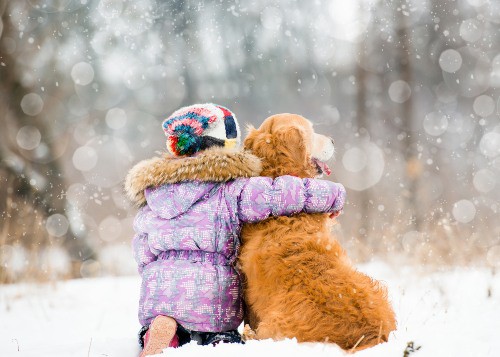They call it “winter wonderland” for a reason. When temperatures drop and the world gets coated in snow, it’s well worth the effort of bundling up to go outside and take in the beauty.
But staying outside for too long, or going out in the extreme cold, can put your health at risk. And if you bring your dog out with you, you could be compromising his health, too.
So how cold is too cold for dogs? And what can you do to keep your pup safe during the chilliest times of the year?
Read on to find out!
Freezing Factors
There’s no one-size-fits-all answer to the question of suitable temperatures for dogs. Many variables need to be taken into account: your dog’s size, coat type, health and age; and the wind, cloud cover and snow type.
Is Your Dog Built For the Cold?

Some dog breeds originated in frigid climates, so they’re inherently well-equipped for being outdoors in the winter. Alaskan Malamutes, Siberian Huskies, and Newfoundlands are among these cold-hardy breeds.
These breeds have thick, heavy coats and undercoats that insulate them against the frigid winds. They’re also large in size, with plenty of interior insulation in the form of dense skin, muscle and fat.
Regardless of breed, dogs that share these characteristics — large size and thick coat — can tolerate lower temperatures than other dogs.
By contrast, small dogs or dogs with thin coats will begin experiencing negative effects of low temperatures much earlier. Breeds like Chihuahuas, greyhounds and Boston terriers are much more sensitive to the cold than their larger, hairier cousins.
Older dogs and dogs with health complications are also less tolerant of cold temperatures. If your dog is elderly or sick, you’ll need to be much more cautious in the cold.
What’s the Weather?
Not all cold weather is the same. 32 degrees on a sunny, windless day will feel much warmer than 32 degrees on a cloudy, windy, snowy day.
Thus, it’s important to consider all aspects of the weather before taking your dog outside.
When looking at weather forecasts, make sure to check the wind chill. It’s a measurement of what the temperature actually feels like once the wind is taken into account.
The air temperature may be 35 degrees, but with a strong wind blowing, the wind chill could drop to 15 degrees. That means that it’ll feel like it’s 15 degrees, and you’ll need to dress and act accordingly.
You’ll also need to take moisture into account. Hypothermia, frostbite and other effects of cold exposure will set in much more quickly if you’re wet.
So if it’s snowing or raining, you and your dog are more at risk than you’d be if the skies were clear. Minimize your time outside if there’s stuff falling from the sky!
How Cold Is Too Cold?

With that said, there are a few rules of thumb you can use to determine if it’s safe for your dog to go out in the cold.
If your dog is small or thin-coated, a wind chill of 40 degrees Fahrenheit is when the potential for danger sets in. You’ll want to limit outdoor-time when temperatures fall below 30 degrees greatly, and in 20-or-below weather, anything longer than a quick potty break should be avoided.
Medium dogs will also start to get chilly at 30 degrees, but supervised outdoor playtime should be fine until temperatures hit 15 degrees. At that point, it’s best to keep your dog inside unless it’s absolutely necessary.
Large dogs or dogs with heavy coats may not notice the cold much at all until it drops to 15 degrees. As with medium dogs, that’s the point at which it’s better to keep them inside.
These temperature estimates are assuming that your dog stays dry. If it’s snowing, raining or otherwise wet outside, your margin for safe temperatures narrows considerably.
In wet weather, all dogs become susceptible to health complications starting at around 40 degrees. Medium and large dogs with heavy coats have a little more leeway, but can still get frostbite or become hypothermic at above-freezing temperatures.
Always monitor your dog for signs of hypothermia and frostbite. These include shivering, weakness, trouble breathing, limping or pain in extremities.
Toasty Tips
You can extend your dog’s outdoor playtime in the cold by taking a few precautions against the chill.
Dressing your dog in winter booties and a waterproof coat will keep him dry and warm for longer periods. Booties also prevent ice and salt from getting stuck in your dog’s paws, where they can cause irritation and frostbite.
When you get home, immediately dry your dog off if he got wet. And make sure there’s a place for him to warm up indoors, whether that’s in front of the fireplace or in a nest of fluffy blankets.
